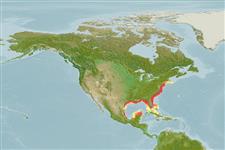>
Eupercaria/misc (Various families in series Eupercaria) >
Sciaenidae (Drums or croakers)
Etymology: Leiostomus: Greek, leios = smooth + Greek,stoma = mouth (Ref. 45335).
More on author: Lacepède.
Environment: milieu / climate zone / depth range / distribution range
पारिस्थितिकी
समुद्री; खारा ड़िमरसल; औशिनोड़िरोमस (Ref. 51243); गहराई सीमा ? - 60 m (Ref. 10325). Subtropical; 43°N - 19°N
Western Atlantic: Massachusetts to northern Mexico; absent in southern Florida.
आकार / वज़न / Age
Maturity: Lm ? range ? - ? cm
Max length : 36.0 cm TL पुल्लिंग / अलिंग; (Ref. 7251); common length : 25.0 cm TL पुल्लिंग / अलिंग; (Ref. 3702); अधिकतम प्रकाशित वज़न: 450.00 g (Ref. 40637); अधिकतम सूचित उम्र: 4 वर्षो (Ref. 12193)
Found usually over sandy or muddy bottoms in coastal waters to about 60 m depth. Occurs in nursery and feeding grounds in river estuaries during summer and fall. Juveniles often stay in the estuarine waters throughout the year. Feeds mainly on worms, small crustaceans and organic detritus. A small specimen of this species was caught in Tokyo Bay, Japan, probably brought in with the ballast water of a ship (Ref. 10325).
Life cycle and mating behavior
परिपक्व अवधि | पुनरुत्पत्ति | मछलीऔ का अंडे देना | अंडे | Fecundity | लार्वा
Robins, C.R. and G.C. Ray, 1986. A field guide to Atlantic coast fishes of North America. Houghton Mifflin Company, Boston, U.S.A. 354 p. (Ref. 7251)
IUCN Red List Status (Ref. 130435)
Threat to humans
Harmless
Human uses
मात्स्यिकी: व्यापारिक; ठहराव / प्रलोभन: occasionally
साधन
Special reports
Download XML
इंटरनेट स्रोत
Estimates based on models
Preferred temperature (Ref.
123201): 13.2 - 26.7, mean 24 °C (based on 314 cells).
Phylogenetic diversity index (Ref.
82804): PD
50 = 1.0000 [Uniqueness, from 0.5 = low to 2.0 = high].
Bayesian length-weight: a=0.00912 (0.00583 - 0.01426), b=3.10 (2.97 - 3.23), in cm total length, based on LWR estimates for this species & (Sub)family-body (Ref.
93245).
Trophic level (Ref.
69278): 3.2 ±0.1 se; based on diet studies.
Generation time: 2.6 ( na - na) years. Estimated as median ln(3)/K based on 2
growth studies.
लौटाव (Ref.
120179): ऊंचा, न्यूनतम जनसंख्या दुगनी समय अवलागत 15 महीने। (K=0.4; tmax=4).
Fishing Vulnerability (Ref.
59153): Low to moderate vulnerability (29 of 100).
Climate Vulnerability (Ref.
125649): Moderate to high vulnerability (47 of 100).
Nutrients (Ref.
124155): Calcium = 101 [57, 196] mg/100g; Iron = 1.09 [0.59, 1.91] mg/100g; Protein = 19.6 [18.6, 20.7] %; Omega3 = 0.351 [0.207, 0.560] g/100g; Selenium = 23.2 [12.9, 43.0] μg/100g; VitaminA = 11.7 [4.5, 36.0] μg/100g; Zinc = 0.981 [0.723, 1.462] mg/100g (wet weight);
